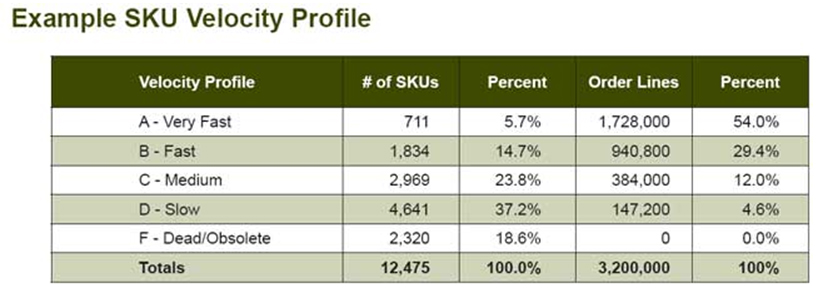Holste Says... |
 |
| ...shippers should do SKU and activity profiling at least once a year. However, whenever there are changes that impact on the order fulfillment process, stock picking and replenishment operations need to be re-visited and optimized as required to remain efficient. |
 |
What do you say? |
 |
| Click here to send us your comments |
|
|
|
What is Activity Profiling?
SKU and activity profiling is the process of gathering and analyzing data for both order profiles (orders per day/shift, lines per order, items per line, etc.) and individual SKU activity (volumes, breakdown by unit of measure, etc.).
Although order and SKU profiling is key to consistently re-optimizing product picking arrangements and processes, few companies seem to have the data readily available even in this age of ERP, WMS, data warehouses and other software systems.
In some cases, the data is available or largely available, but is in different software systems. The data from these different sources must be merged. In other cases, key data is not available or is very hard to get at. Examples of the former might include product dimensions and weight; examples of the latter might include order line detail, which can be obtained, but only after a major effort by the IT department to search through archived data.
In all cases, companies must carefully look at both what data is available and how accurate that data is.
Data Needed for Order Picking System Analysis
To determine order picking strategies and technologies, companies need to obtain and analyze the following types of data:
- Order mix distribution (family mix, handling unit, order increment);
- Lines per order distribution;
- Cube per order distribution; and
- Lines and cube per order distribution.
Analysis should, in part, develop a SKU velocity profile, similar to the chart below.

The analysis will then also typically involve breaking this data down into movement volumes by different handling/picking units, such as full pallet, full case and split case activity.
The next step is an iterative process, and is constrained by many factors, especially if the analysis is for an existing building rather than a “green field site.” It may also be that a company wants to look only at one area, such as piece picking.
A comprehensive analysis will include both analyzing where some group of products (such as the “Very Fast” full case movers) will be stored, in what type of storage mode (e.g., double deep pallet flow rack, half pallet, etc.) and what picking strategy/technology will be used including automated piece picking and Goods-to-Person solutions.
The analysis can get very sophisticated; for example, in some businesses it makes sense to look at items that are almost always ordered as single line items, and store those in a separate area of the DC. It can also pay to look at SKU/Order relationships – a relatively slow moving SKU might make sense to store in the high-velocity area, if when it is ordered, it almost always is ordered with a Category “A” product.
The key points:
- Order picking strategies are closely tied to sales channel order profiles and inventory replenishment;
- Different order picking technologies are best suited to SKU velocity profiles for a given unit of measure; and
- Different order picking system investments will have different ROI depending on the level of activity within a pick zone. SKU and order activity profiling is essential to optimizing these decisions.
Final Thoughts
Given today’s dynamic marketplace, shippers should do SKU and activity profiling at least once a year. However, whenever there are changes that impact on the order fulfillment process, stock picking and replenishment operations need to be re-visited and optimized as required to remain efficient. If automated picking technologies are being considered, it is essential that DC operations be optimized in order to realize full benefit from the investment.
Any reaction to this Expert Insight column? Send below.
Your Comments/Feedback
|